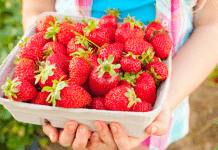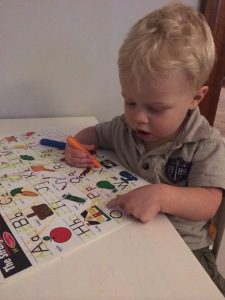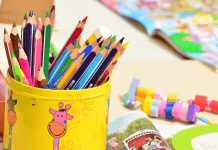We know that exposure to language-rich environments in infancy and toddlerhood sets the stage for a lifetime of literacy learning. Therefore, reading with our kids is one of the most important things we can do to promote literacy – even reading to babies from birth.
But it’s also worth noting that literacy development is an incredibly multifaceted process, involving experiences in reading, writing, speaking AND listening. These skills are all interconnected, and they are all valuable for literacy development.
As a writing teacher and mom to a toddler, I’m particularly interested in helping my child develop not only as a reader, but also as a writer. We typically don’t think of kids as writers until they begin to write letters or their name. Yet even our babies and young toddlers are already developing many of the cognitive and physical skills necessary for writing!
The great news is that we do not need to be literacy experts — or even Pinterest experts — to get our small children writing. We can simply integrate opportunities for writing within our ordinary routines.
1. Call early writing attempts WRITING.
When we refer to writing with babies and toddlers, we don’t mean that small children are actually writing words or sentences. Rather, we are talking about the development of pre-writing skills or all of the activities that prepare them to write letters and words.
The way your baby is learning to grasp food and smear it around her tray? She is building valuable fine motor skills necessary for holding a crayon or pencil. Those scribbles your toddler is making on pieces of paper or on your white walls? Early attempts at expression. (Maybe you have the marks of a future Steinbeck!)
We can encourage our child’s writing development by naming and affirming their early writing attempts. For example, this morning I wrote my 17-month old’s name on a sheet of paper, and he tried to copy me by scribbling over the top of the letters. Saying something in that moment like, “Great job! You’re writing your name!” helps affirm to our children that their marks on paper do have meaning.
2. Make writing spaces and utensils accessible.
Only a crazy mom would let a toddler loose with a writing utensil, right?! Luckily, there are easy ways to create writing/drawing spaces in your home while also keeping your kids (and maybe your furniture) safe. For older babies and toddlers, writing and drawing are similar skills, but over time your child will differentiate between the two.
Finger writing activities are most appropriate for infants (6 months +), but at some point after your baby’s first birthday, they will be able to start gripping and holding crayons. Here are some simple ways to create writing spaces for littles:
- Cover a kids’ table (or a large box) in paper and keep washable crayons or chalk nearby. Encourage your toddlers to completely cover the all blank space before you change out the paper for less frequent paper replacement.
- Keep coloring surfaces in places where your kids can easily access them. We love these Melissa and Doug learning mats, which specifically encourage letter and number tracing. I keep both the mats and crayons on a lower shelf in the kitchen, and my toddler pulls them out all the time. We also have bath crayons he uses in the tub.
- Turn your baby or toddler’s high chair tray into a writing space by spreading out a thin layer of flour, applesauce, or edible paint and showing them how to write with their fingers.
- Squirt a little paint (or even shaving cream) into a plastic bag, seal it well, and tape it securely to a window or on a kids’ table. Show your child how to write letters in it with their finger. Specific directions for this activity here.
- Find an open wall in your house and turn it into a chalk wall. If you don’t want to paint or don’t have space for a full wall, chalkboard decals are easy to find.
3. Include kids in your own writing.
One of the most valuable things you can do to help expose your kids to writing is to let them see that YOU are a writer. We live in an extremely text-based society, so it’s likely you write much more than you think. Text messages, grocery lists, and notes to the babysitter all count. Allow your children see you writing, and invite them to join. For example, when you’re making your grocery list, give your toddler a crayon and let him add to the list, too.
In addition, talk about writing with your kids! One of my favorite teaching strategies is called “thinking aloud.” Narrate the decisions you’re making as you write. Writing is a complicated process that involves making many rhetorical decisions so it’s good practice to explain these steps to your kids. You can even start doing this in front of your babies! Eventually, as your child’s brain matures, they will be able to follow some of your cognitive moves.
Here’s an example of how I do this : “Hey, buddy, I got a text message from your Nana. [Read message aloud.] Hmm, she asked how our day is going. What should I write back? Well, this morning we went to Costco, and they had chocolate pretzel samples, so I’d say our day has been pretty good, wouldn’t you? OK, I’m writing, ‘Our day has been good, g-o-o-d, because we got to eat chocolate pretzels!’”
Or,“What do we need at the store? Bread, eggs, an avocado, and bananas. Actually, let’s organize that so it’s easier for me to use. First, we usually go to the produce section. So, let’s revise the list by crossing out banana down here and writing it again at the top. Okay, I’m writing a B to start spelling banana!”
How this works for you depends somewhat on your child’s verbal skills. My child isn’t talking enough yet to answer my questions and help me compose these messages, but older toddlers can chime right in and help you write! Yes, doing this sounds ridiculous when it is coming out of your mouth, and maybe your toddler will stop listening after the first sentence. But over time, this simple exercise helps a child build vocabulary and internalize rhetorical skills they will need to become strong writers.
Early Literacy Resources
If you are interested in learning more specifically what writing-related tasks are appropriate for your child at what ages, check out these resources.
- Writing milestones for baby, toddler, and preschool children (PBS)
- Lists of phases in writing and drawing development (Zero to Three)
- Early literacy resources (American Academy of Pediatrics)


















